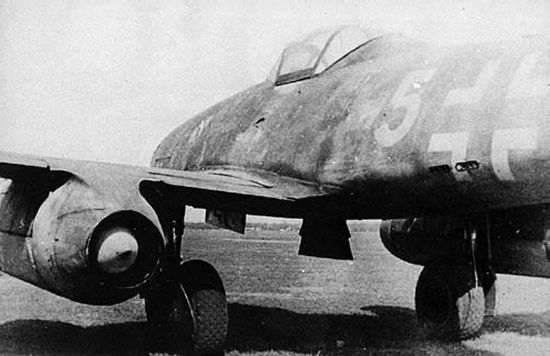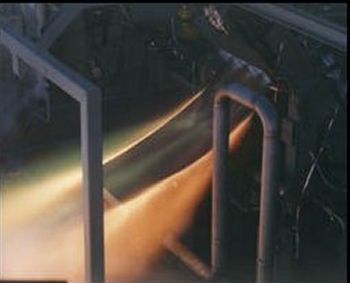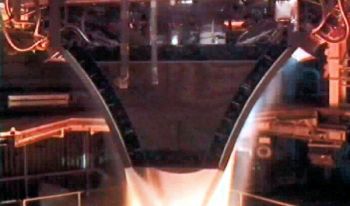|
||||||||||
|
|
||||||||||
|
||||||||||
|
|
||||||||||
|
|
|
||||||||||||||
|
Though the concept of the aerospike nozzle has been around for many years, little actual flight or test experience
has been available until recently. Nonetheless, we will take a brief look at the effort to develop and test
spike nozzles, particularly those used on the X-33.
Early Development:The first serious studies of spike nozzles were performed in Germany in conjunction with the development of the turbojet engine. Engines, like those used on the Messerschmitt Me 262 shown below, utilized a plug centerbody to vary the throat area for better performance.

View of the spike centerbody used in the engine nozzle on the Me 262
1950s through 1970s:NASA, the United States Air Force, and Rocketdyne together spent over $500 million on the development of aerospike engines during the 1950s, 1960s, and 1970s. The development effort, conducted by the NASA Lewis Research Center (now known as NASA Glenn) in Cleveland, OH, and by Rocketdyne's Nevada test facility, tested aerospike engines ranging in size from subscale cold-flow models to a full-scale 250,000 lb thrust engine. These tests included 73 ground tests of full-sized engines totaling over 4000 seconds of operation. Similar work was underway in West Germany from 1965 to the early 1970s in support of a heavy lift launch vehicle called Neptune. The propulsion arrangement for this concept consisted of a "toroidal plug nozzle" that behaved much like an aerospike with primary and secondary flows.
Current Development:The early NASA and Rocketdyne research efforts have led to the development of the XRS-2200 linear aerospike engine that was to be used on the X-33 test vehicle. Four of these engines, subscale versions of those planned for the VentureStar vehicle, were built. Two were installed on the X-33 while the other two were being used in ground tests at the NASA Stennis Space Center in Mississippi. Each engine employed 20 combustion chambers, ten aligned on the end of each ramp centerbody, to produce 206,400 lb of thrust at sea level. The full-sized RS-2200 engine intended for the VentureStar was to have 14 combustion chambers (7 per side) to produce 431,000 lb of thrust. The maximum specific impulse of these engines is estimated at 455 seconds. The first two test engines began test-stand testing at NASA Stennis in September 1999. The test program called for 41 firings: 6 initial firings to develop ignition sequencing, 8 to analyze engine performance at different power levels, 11 firings of two separate flight-rated engines, and 16 firings of the two flight-rated engines together. No rocket plug nozzle of any type is believed to have actually flown until the Linear Aerospike SR-71 Experiment (LASRE) began at the NASA Dryden Flight Research Center in 1997.

Flight test of the LASRE aerospike engine mounted on the SR-71Mounting a 10% scale half-model on the back of an SR-71 Blackbird high-speed research aircraft, NASA engineers used the flights to measure the net thrust, plume expansion, plume aerodynamics, and other parameters of the engine. Tests were to be performed from Mach 0.6 at 15,000 ft to Mach 3.2 at 80,000 feet in an attempt to measure the altitude compensation characteristics of the design.

Closeup view of the LASRE test engine mounted on the SR-71Although the aerospike engine test program experienced delays, as did the entire X-33 project, the aerospike engine did successfully complete a number of test firings, as illustrated below.

Overhead view of a test firing [from Lockheed, 2001]

Aerospike engine being test fired [from Lockheed, 2001]

Aerospike engine being test fired [from Lockheed, 2001]In addition to the US test program, basic research on aerospike engines has also been undertaken in Germany, France, and Japan in recent years. The Japanese research, in particular, is quite interesting as it is intended to support the H-2A rocket and a single-stage-to-orbit (SSTO) vehicle called the HOPE-X. Unfortunately, Japan's sagging economy has caused significant cutbacks in the nation's space program and little more than concept studies and some basic experimental performance results have been generated thus far. |


|
Aircraft | Design | Ask Us | Shop | Search |

|
|
| About Us | Contact Us | Copyright © 1997- | |||
|
|
|||